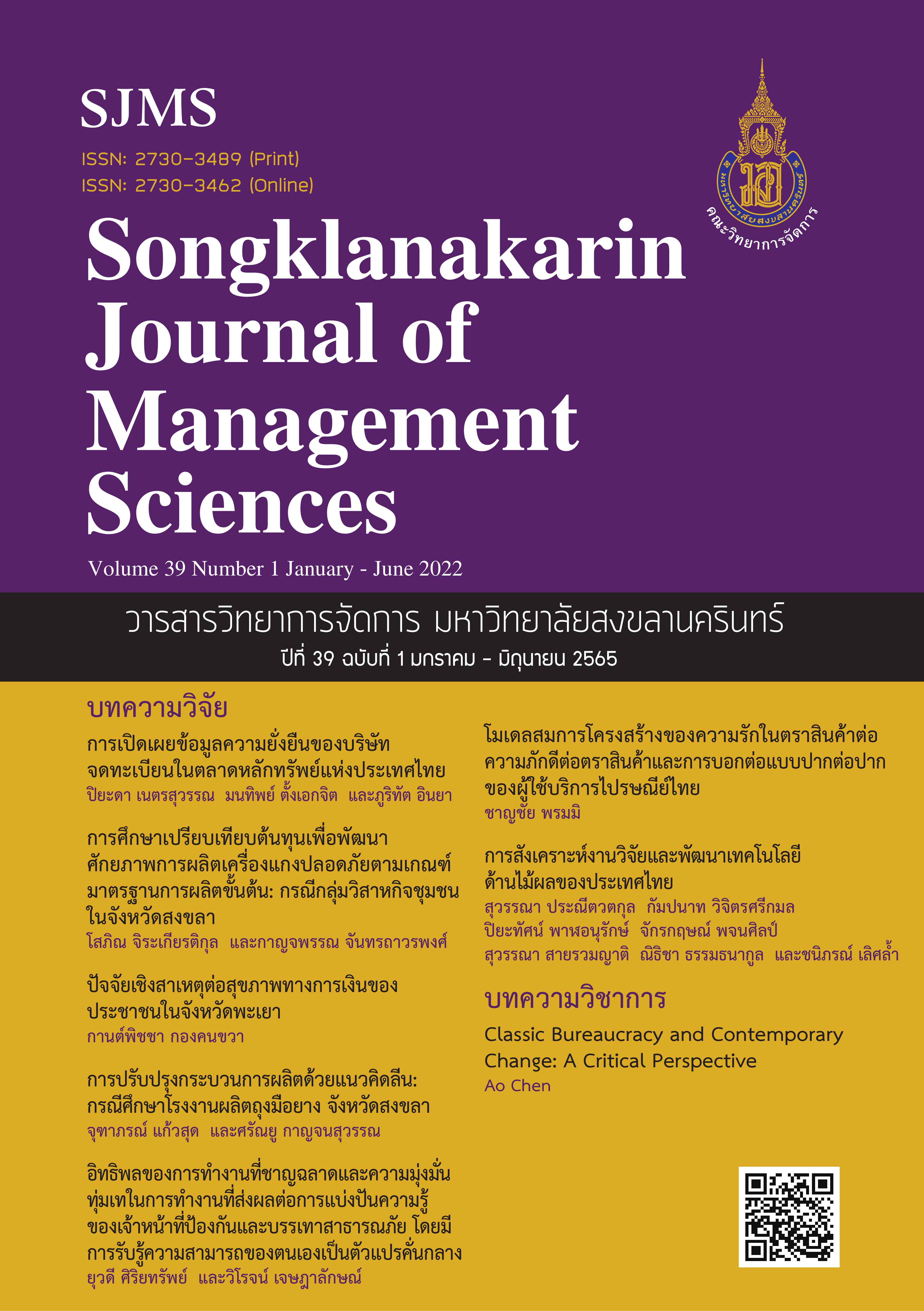Causal Factors in Financial Health among Resident in Phayao Province
Main Article Content
Abstract
The objectives of this research are: (1) to evaluate the level of financial health and financial literacy (2) to investigate the factors influencing financial health. The data were obtained through a questionnaire with 384 respondents in Phayao province between age 21 to 60 by multi-stage sampling and employed the path analysis to identify causal relationship. The empirical results found a moderate level of the financial health and a high level of the financial literacy among all participants. The 21-30 year old age group had the highest score, whereas the 51-60 year old age group had the lowest score both of the financial health and financial literacy. In addition, path analysis showed evidence of a significant increase in the financial health caused by marital status, education level, income, expense, knowledge of interest rate, knowledge of inflation, and knowledge of risk diversification; on the contrary, age and occupation could cause the decrease in financial health. The finding of this research shows the importance of having a good financial health which could solve the problem of spending, debt, and personal financial liquidity.
Article Details

This work is licensed under a Creative Commons Attribution-NonCommercial-NoDerivatives 4.0 International License.
All published articles are SJMS’s copyright. The editorial board allows all published articles to be copied, excerpted, or disseminated with academic citation.
References
Agarwalla, K. S., Barua, K. S., Jacob, J., & Varma, R. J. (2015). Financial literacy among working young in urban India. World Development, 67(1), 101-109.
Agnew, R. J., Bateman, H., & Thorp, S. (2013). Financial literacy and retirement planning in Australia. Numeracy, 6(2), 1-25.
Auepiyachut, W. (2017). Financial Literacy: Determinants and its Implications for Saving Behavior. Humanities and Social Sciences Burapha University, 25(47), 67-93.
Bank of Thailand. (2015). Financial Literacy Measurement and Saving for Retirement. Retrieved December 25, 2019, from https://www.bot.or.th
Beckmann, E. (2013). Financial literacy and household savings in Romania. Numeracy, 6(2), 1-22.
Behrman, R. J., Mitchell, S. O., Soo, K. C., & Bravo, D. (2012). How financial literacy affects household wealth accumulation. American Economic Review, 102(3), 300-304.
Clercq, D. B., & Venter, J. (2009). Factors influencing a prospective chartered accountant’s level of financial literacy: an exploratory study. Meditari Accountancy Research, 17(2), 47-60.
Halilovic, S., Zaimovic, A., Berilo, A. A., & Zaimovic, T. (2019). Financial literacy assessment in Bosnia and Herzegovina. Procedia Computer Science, 158(1), 863-843.
Hastings, S. J., & Mitchell, S. O. (2020). How financial literacy and impatience shape retirement wealth and investment behaviors. Journal of Pension Economics and Finance, 19(1), 1-20.
Huston, J. S. (2010). Measuring financial literacy. The Journal of Consumer Affairs, 44(2), 296-316.
Inlakorn, S. (2016). Personal Finance (5th Ed.). Bangkok: Kasetsart University Press.
Kapoor, J., Dlabay, L., & Hughes, J. R. (2013). Focus on Personal Finance: An Active Approach to Help You Develop Successful Financial Skill (4th Ed.). New York: Mc Graw-Hill.
Kenan Foundation Asia. (2015). Improvement for better Finance in Thailand. Retrieved December 22, 2019, from https://thaipublica.org
Koenen, B. T., Lusardi, A., Alessie, R., & Rooij, V. M. (2017). How financially literate are women? An overview and new insights. The Journal of Consumer Affairs, 51(2), 255-283.
Konkaew, W. (2014). The Health Behavior of Elderly of Klongtumru Sub-district, Amphoe Mueang Chon Buri. Retrieved December 28, 2019, from http://www2.gspa.buu.ac.th
Krejcie, V. R., & Morgan, W. D. (1970). Determining Sample Size for Research activities. Educational and Psychological Measurement, 30(3), 607-610.
Lusardi, A., & Mitchell, S. O. (2011). Financial literacy and planning: implications for retirement wellbeing. Retrieved December 28, 2019, from https://www.nber.org
Mihalcova, B., Csikosova, A., & Janoskova, M. (2014). Financial literacy – the urgent need today. Procedai – Social and Behavioral Sciences, 109(1), 317-321.
Nampud, S., Chareanjittrakram, A., & Wiwatthana, S. (2014). Strategic Personal Finance Management (6th Ed.). Bangkok: Thammasat University Press.
National Statistical Office of Thailand. (2019a, 2019b, 2019c). Statistics of household income and expenditure and their distribution. Retrieved December 20, 2019, from http://statbbi.nso.go.th
Posttoday. (2020). Financial health. Retrieved October 1, 2020, from https://www.posttoday.com
Saranjit, T. (2015). Problem of Poverty in Thailand. EAU Heritage Journal Social Science and Humanity, 5(2), 12-21.
Sektrakul, K. (2010). Personal Financial Planning. Retrieved December 2, 2019, from https://member.set.or.th
Supakitvanitchkul, A., & Phasunon, P. (2016). A Comparison of Savings Behavior and Financial Management before the Retirement: Case Study of the Staffs in Silpakorn University, Sanamchan Campus, Nakhon Pathom. Veridian E-Journal Silpakorn University Humanities, Social Sciences, and Arts, 9(2), 375-389.
The Stock Exchange of Thailand. (2011). Comprehensive Financial Planning (2nd Ed.). Bangkok: Boonsiri Printing Co., Ltd.
The Stock Exchange of Thailand. (2019). Financial Health Check. Retrieved December 30, 2019, from https://www.set.or.th
Vanichbuncha, K. (2019). Structural Equation Modeling Analysis with AMOS (3rd Ed.). Bangkok: Threelada Limited Partnership.
Wongjan, R. (2015). Personal Financial Management (3rd Ed.). Bangkok: Boonsiri Printing Co., Ltd.
Worthington, C. A. (2006). Predicting financial literacy in Australia. Financial Services Review, 15(1), 59-79.

